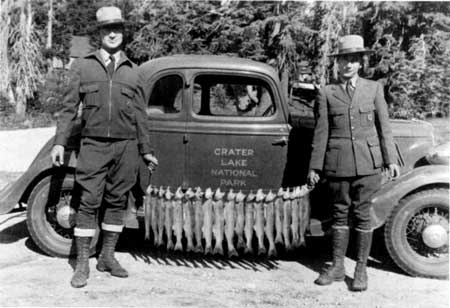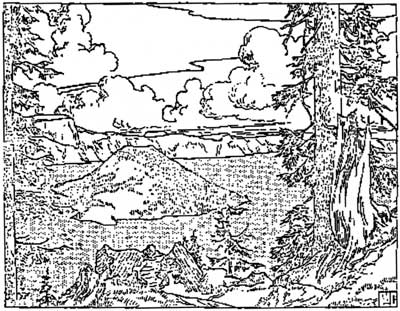A Fish Tale You Can Believe
During my summer seasons as a ranger, I have answered many questions about America’s deepest lake. “Are there fish in the lake?” is one of the most frequently asked. The answer is yes, but the explanation cannot end there. How the fish arrived in Crater Lake is relevant because no streams breach the caldera wall.
In 1888, William Gladstone Steel — who was later known as the park’s founder — decided that people needed a recreational diversion upon arrival at the Lake of Blue Waters. As if the breathtaking beauty was not enough! So Steel decided to stock Crater Lake.
Initially, fingerlings (rainbow trout) were brought from the Rogue River to Crater Lake. Over a period of 40-50 years, five more species of fish were introduced: brook and brown trout, steelhead, coho (silver) salmon, and kokonee salmon. I am no ichthyologist, but it seems strange that Will and his associates placed steelhead (a rainbow trout that spends part of its life cycle in the ocean) and coho salmon in a lake with no inlets or outlets. Since both of these species move from ocean to fresh water streams to spawn, neither of them would survive very long in the closed system of Crater Lake.
For that matter, there have been no sightings of brook or brown trout since the 1960s. Among the six introduced to the lake, the only survivors appear to be the rainbow trout and kokonee salmon. Both are well equipped for Crater Lake’s cold, deep water.
Since the two existing species of fish in the lake were put there for recreational purposes, I bet all you anglers are wondering how the fishing is at Crater Lake. Writing as one who has been on a four year quest to catch the “Crater Lake Monster,” I feel qualified to provide some insight. Whether or not you will tell fishing stories about Crater Lake depends on what your expectations are before you start to fish.
If you come to the seventh deepest lake in the world and expect to fish the whole lake, you are badly mistaken. Just one trail provides access to the lake’s shoreline. The Cleetwood Cove Trail is one mile long and involves 700 feet of elevation change. Open only during the months of snowfree weather (generally July, August and September), the trail allows people to walk along the shoreline for roughly one quarter mile.
Shoreline fishing is one of the two options you have. The second involves taking the concessioner’s boat tour, which makes a stop et Wizard lsland. Since fishing from the tour boat is not allowed, the island is probably the best place to cast a line. I enjoy taking the morning’s first boat (usually 10 a.m.) and staying on the island until the
Before you invest in a boat tour to reach the island, you should know a few things. Crater Lake’s rainbow trout are a finicky species, but can grow rather large in this lake with few natural predators. Notwithstanding their larger size, the rainbow trout are fewer in number than the smaller and more plentiful kokonee salmon. You should not be surprised if, on your first five casts, you reel in a kokonee instead of a rainbow. It has happened to me on many occasions. In fact, there are days when getting a cast fully retrieved without a kokonee on the line can be the toughest challenge of all.

Rangers displaying catch, 1938.
Another challenge is making your way around the shoreline of Wizard Island. The sharp, loose lava is known for extracting bits and pieces of skin from brave visitors, primarily from the knees and palms. If you survive the ever-biting kokonee and all the scrapes and scratches, then you may be ready for a large rainbow trout to come your way. How large? Well, the rumors do fly!
Like most fishing spots, the size of the largest rainbow trout ever caught in the lake is debatable. The park’s aquatic biologist, Mark Buktenica, believes it to be the six pound, 27 inch monster retrieved m one of his research nets during the summer of 1991. I happened to be on the lake with Mark the day this fish was captured, so I can confirm this claim. The biggest rainbow trout I have caught with hook and line measured 21 inches long and weighed just under three pounds.
What did I use to catch this beast? I don’t mind sharing my secrets because the fish were introduced and really have no natural place in the lake’s ecosystem. Consequently, as long as they remain there, I will do my part m removing them and perhaps you can do your fair share, too. A steel blue-colored rooster tail is what helped me to catch that 21 inch trophy rainbow. Depending on the time of season, other “hot” lures to use are: crawdads (the plastic variety, as no live or organic bait is allowed), any variety of orange, black or yellow rooster tails, flat fish (bright silver works well). If you’re a purist, flies are always a good bet (a caddie-like offering may work especially well in mid to late summer).
Not only is the type of lure you choose important to your success, but so is your delivery style. The key to delivery is to be unobtrusive. Whether you are drifting a fly through shallow coves or fishing the deep dropoffs with a spinning setup, approach your target slowly and quietly. There is so little natural disturbance around the island that even the slightest shadow or rockfall will announce your presence. If the rainbow see you before your delivery is made it is best to move somewhere else because your chance at that spot is gone.
This fish story about Crater Lake would not be complete without two final details. First, if you are planning to fish all day from Wizard Island, be sure to leave yourself enough time to get back to the dock for the last boat tour of the day. Hurrying over the loose lava is never a good idea and it is just bad manners to make the ranger look for you. Second, remember that whatever you decide to take home or back to camp must make the 700 foot ascent back up the Cleetwood Cove trail. Making friends with some of the more sturdy looking folks on your boat ride back to the dock at Cleetwood Cove may be a good idea if you happen to catch the “Crater Lake Monster.”

Illustration by L. Howard Crawford, Nature Notes from Crater Lake, 1935.
***previous***

